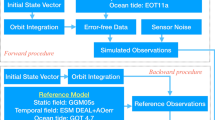Abstract
Currently, aliasing error of temporal signal model becomes the main factor constraining the accuracy of temporal gravity field. In provision of three types of satellite formations, i.e., GRACE-type, Pendulum-type and n-s-Cartwheel-type, which are suitable for gravity mission and composed of observation in different directions, here we design two cases and conduct a simulation experiment on the feasibility to apply satellite formations for eliminating the influence from the aliasing error of ocean tide models. The result of our experiment shows that, when the aliasing error is disregarded, n-s-Cartwheel formation can provide the best conditions for gravity field determination, which, compared with GRACE-type, can improve the accuracy by 43%. When aliasing error of the ocean tide model acts as the main source of error, the satellite formation applied in dynamic method for gravity field inversion cannot eliminate aliasing or improve the accuracy of gravity field. And due to its higher sensitivity to the high-degree variation of gravity field, the Cartwheel-type formation, which includes the radial observation, can result in the gravity field containing more high-frequency signals for the ocean tide model error, and lead to a dramatically larger error.
Similar content being viewed by others
References
Chen J L, Wilson C R, Swo K W. 2006. Optimized smoothing of gravity recovery and climate experiment(GRACE) time-variable gravity observations. J Geophys Res, 111: B06408
Ditmar P, Teixeira da encarnacao J, Hashemi Farahani H. 2011. Under-standing data noise in gravity field recovery on the basis of inter-satellite ranging measurements acquired by the satellite gravimetry mission GRACE. J Geod, 86: 441–465
Elsaka B. 2010. Simulated satellite formation flights for detecting temporal variations of the earth’s gravity field. Doctoral Dissertation. Bonn: University of Bonn, Germary
Han S C, Jekeli C, Shum C K. 2004. Time-variable aliasing effects of ocean tides, atmosphere, and continental water mass on monthly mean GRACE gravity field. J Geophys Res, 109: B04403
Jekeli C. 1996. spherical harmonic analysis aliasing and filtering. J Geod, 70: 214–223
Kim J. 2000. Simulation study of a low-low satellite-to-satellite tracking mission. Doctoral Dissertation. Austin: University of Texas at Austin
Klees R, Revtova E A, Gunter B C, et al. 2008. The design of an optimal filter for monthly GRACE gravity models. Geophys J Int, 175: 417–432
Kurtenbach E, Mayer-Gurr T, Eicker A. 2009. Deriving daily snapshots of the Earth’s gravity field from GRACE L1B data using Kalman filtering. Geophys Res Lett, doi:10.1029/2009GL039564
Loomis B D, Nerem R S, Luthcke S B. 2012. Simulation study of a follow-on gravity mission to GRACE. J Geod, 86: 319–335
Luo Z C, Li Q, Zhang K, et al. 2012. Trend of mass change in the Antarctic ice sheet recovered from the GRACE temporal gravity field. Sci China Earth Sci, 55: 76–82
Lyard F, Lefevre F, Letellier T, et al. 2006. Modelling the global ocean tides: Modern insights from FES2004. Ocean Dyn, 56: 394–415
Ray R D, Luthcke S B. 2006. Tide model errors and GRACE gravimetry: Towards a more realistic assessment. Geophys J Int, 167: 1055–1059
Savcenko R, Bosch W. 2008. EOT08a-empirical ocean tide model from multi-mission satellite altimetry. Report No.81. Deutsches Geodatisches Forschungsinstitut (DGFI), Munchen, Germany
Seo K W, Wilson C R, Han S C, et al. 2008a. Gravity Recovery and Climate Experiment (GRACE) alias error from ocean tides. J Geophys Res, 113: B03405
Seo K W, Wilson C R, Chen J L, et al. 2008b. GRACE’s spatial aliasing error. Geophys J Int, 172: 41–48
Sneeuw N, Flury J, Rummel R. 2005. Science requirements on future missions and simulated mission scenarios. Earth Moon Planet, 94: 113–142
Tapley B D, Bettadpur S, Ries J C, et al. 2004. GRACE measurements of mass variability in the Earth system. Science, 305: 503–505
Visser P, Sneeuw N, Reubelt T, et al. 2010. Space-borne gravimetric satellite constellations and ocean tides: Aliasing effects. Geophys J Int, 181: 789–805
Wahr J, Molenaar M, Bryan F. 1998. Time variablility of the Earth’s gravity field: hydrological and oceanic effects and their possible detection using GRACE. J Geophys Res, 103: 30205–30229
Wahr J, Swenson S, Zlotnicki V, et al. 2004. Time-variable gravity from GRACE: First results. Geophys Res Lett, 31: L11501
Watkins M, Sprague G, Case K, et al. 2008. Time Variable Gravity Mapping Mission (Grace Follow-On/Grace II) Study. GRACE Science Team Meeting. 237–250
Wiese D N, Folkner W M, Nerem R S. 2009. Alternative mission architectures for a gravity recovery satellite mission. J Geod, 83: 569–581
Wiese D N, Visser P, Nerem R S. 2011. Estimating low resolution gravity fields at short time intervals to reduce temporal aliasing errors. Adv Space Res, 48: 1094–1107
Zenner L, Gruber T, Jäggi A, et al. 2010. Propogation of atmospheric model errors to gravity potential harmonics-impact on GRACE de-aliasing. Geophys J Int, 182: 797–807
Zhao Q, Jiang W P, Xu X Y, et al. 2011. Analysis of influence of aliasing effects on GRACE gravity solution. J Geod Geodyn, 31: 123–126
Zhao Q. 2012. Methodology research and simulation analysis of the Earth’s gravity field determination using satellite formation. Doctoral Dissertation. Wuhan: Wuhan University, China
Author information
Authors and Affiliations
Corresponding author
Rights and permissions
About this article
Cite this article
Zhao, Q., Jiang, W., Xu, X. et al. Feasibility study on application of satellite formations for eliminating the influence from aliasing error of ocean tide model. Sci. China Earth Sci. 58, 474–481 (2015). https://doi.org/10.1007/s11430-014-5010-5
Received:
Accepted:
Published:
Issue Date:
DOI: https://doi.org/10.1007/s11430-014-5010-5




